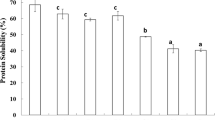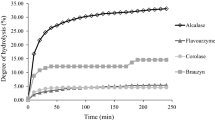Abstract
High moisture content (89%) along with high enzymatic and bacteriological activity in Bombay duck (Harpodon nehereus) meat are responsible for short shelf life and disintegration of meat in cooking. Minimum solubility was at pH 5 (iso-electric point) of muscle protein. Citric acid- sodium citrate buffer (pH 5) with 0.2% potassium sorbate was very effective in reducing moisture in dressed fish and in increasing shelf life up to 4 days at ambient temperature (25–28 °C). Reduction in moisture in meat improved its cooking quality and gel formation capacity with increased protein content. Fish meat contained 1.0–1.5% NaCl and produced stronger gel by using 2% NaCl than conventionally prepared gel with 4% NaCl. Washing fish mince with cold water followed by pressing at pH 5, gave fish cake with more salt soluble protein and better gel strength (>500 gcm) than the same operation done at ambient temperature.






Similar content being viewed by others
References
Anon (1990) Proposal for a council regulation (EEC/C2) laying down the health conditions for the production and the placing on the market of fishery products. Official J EEC / C2 84:58–70
AOAC (1975) Official methods of analysis, 12th edn. Association of Official Analytical Chemists, Washington DC
Chakrabarti R, Gupta SS (2000) Characteristics of gel from meat of twelve species of fish from Visakhapatnam coast. Fish Technol 37:5–7
Chakrabarti R, Varma PRG (2000) The sensitivity of halotolerant Aspergillus flavus, Aspergillus niger and Penicillium sp. to propionate, sorbate and benzoate. J Food Sci Technol 37:72–74
Connell JJ (1968) The effect of freezing and frozen storage on the proteins of fish muscle. In: Hawthorn J, Rolfe EJ (eds) Low temperature preservation of foodstuffs. Pergamon, Oxford, pp 333–358
Connell JJ (1980) Control of fish quality, 2nd edn. Fishing News Books Ltd, Farnham, pp 137–138
Conway EJ (1950) Microdiffusion analysis and volumetric error, 3rd edn. Crossby Lock Wood and Sons Ltd, London, pp 87–107
Doeshurg UJ, Lamprecht EC, Elliott MC, Reid DA (1969) The use of sorbic acid in salted fish. J Food Technol 4:339–341
Dyer W, French HV, Snow JM (1950) Proteins in fish muscle. I. Extraction of protein fractions in fresh fish. J Fish Res Board Can 7:585–596
Fiske CH, Subbarow Y (1925) The colorimetric determination of phosphorus. J Biol Chem 66:375–400
FAO (2003) Year book of statistics (1992–2001). Food Agriculture Organization, Rome
Karel M (1973) Protein interactions in bio-systems: protein–lipid interaction. J Food Sci 38:756–763
Kakatkar A, Sharma A, Venugopal V (2003) Hydration of muscle proteins of Bombay duck (H. nehereus) during acetic acid induced gelation and characteristics of gel dispersion. Food Chem 83:99–106
Kondoran MK, Solanki KK, Venkataraman R (1969) Studies on the storage behavior of laminated and commercial Bombay duck. Fish Technol 6:140–147
Lowry OH, Resebrough NJ, Farr AL, Randall RJ (1951) Protein measurement with the Folin Phenol reagent. J Biol Chem 193:265–275
Niven CF Jr, Jeffrey MB, Corlett DA (1981) Differential plating medium for quantitative detection of histamine producing bacteria. Appl Env Microbiol 41:321–322
Okada M (1959) Gelometer. Bull Tokai Reg Fish Lab 24:67–68
Pan BS, Lee DJ, Lin LP (1980) Studies on a minced squid product; effect of raw materials and ingredients on the texture of the product. In: Connell JJ (ed) Advances in fish science and technology. Fishing News Books Ltd, Farnham, pp 434–437
Radhakrishna AG, Solanki KK, Venkataraman R (1973) Preliminary studies on freezing characteristics of Bombay duck (Harpodon nehereus). Fish Technol 10:124–130
Raman M, Mathew S (2005) Effect of structural protein on the textural characteristics of rohu and squid at various cooking temperatures. J Food Sci Technol 42:430–433
Shewan JM, Macintosh RG, Tucker CG, Ehenberg ASC (1953) The development of a numerical scoring system for the sensory assessment of spoilage of wet fish stored in ice. J Sci Food Agric 4:283–297
Snedecor GW, Cochran WG (1967) Statistical methods. Oxford and IBH Publ Co, Calcutta, pp 33–65
Suzuki T (1981) Fish and krill protein. Applied Science Publ Ltd, London, pp 62–67
Walk TS, Walk E (1969) Bio-chemistry and molecular biology, vol 1. Academic, New York, pp 365–371
Winton AL, Winton KB (1958) The analysis of foods. Wiley, London, pp 800–801
Warrier SBK, Ninjoor V, Nadkarni GB (1985) Involvement of hydrolytic enzymes in the spoilage of Bombay duck (Harpodon. nehereus). In: Proc Sym Harvest and Post harvest Technology of Fish organized by Soc Fish Technol (India), 24–27 November 1982, Kochi, p 470–472
Acknowledgements
Author is grateful to Meenakumari B, Director, Central Institute of Fisheries Technology, Kochi for permission to publish this paper. Technical assistance rendered by Gaikwad S, Triveni A, Bait P and Waghmare T is thankfully acknowledged.
Author information
Authors and Affiliations
Corresponding author
Rights and permissions
About this article
Cite this article
Rupsankar, C. Improvement of cooking quality and gel formation capacity of Bombay duck (Harpodon nehereus) fish meat. J Food Sci Technol 47, 534–540 (2010). https://doi.org/10.1007/s13197-010-0092-3
Revised:
Accepted:
Published:
Issue Date:
DOI: https://doi.org/10.1007/s13197-010-0092-3




